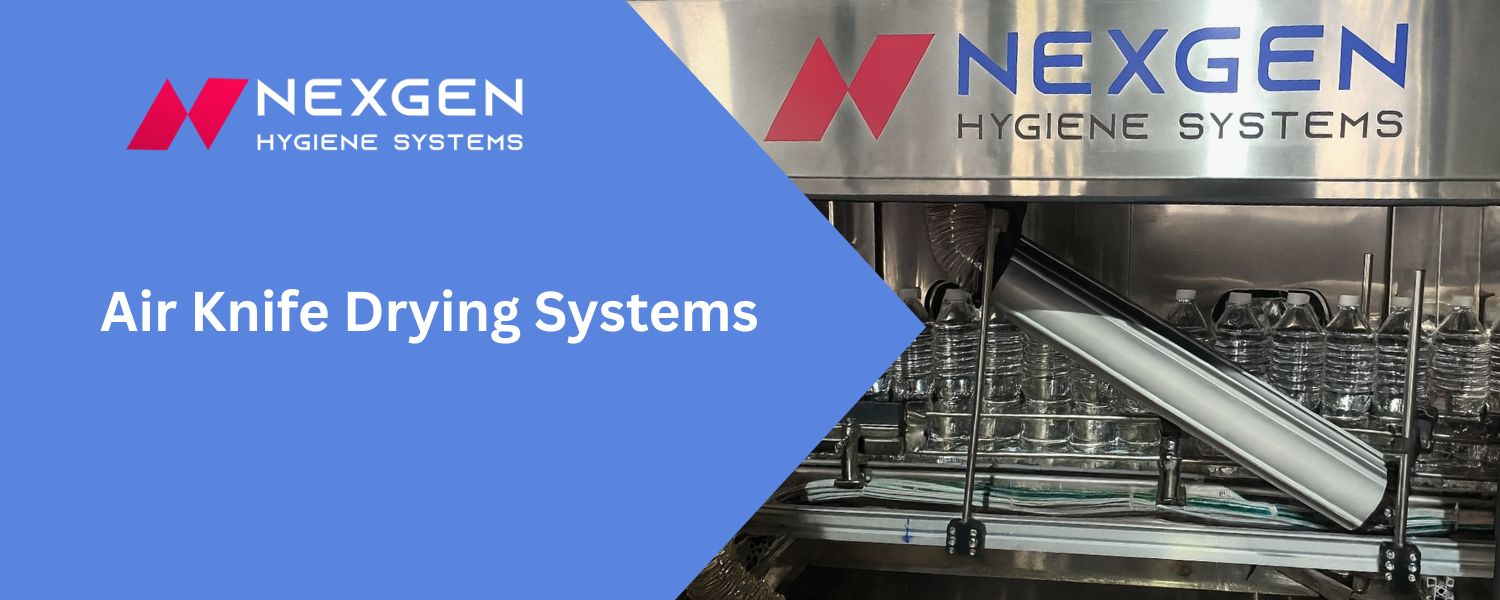Label adhesion is one of the most overlooked yet critical challenges in beverage bottling plants. Bottles that are even slightly damp from condensation or rinsing lines often suffer from poor label sticking, leading to wasted labels, production delays, and compliance risks. For plant managers and executives, this translates into higher costs and reduced efficiency on the line.
An air knife drying system offers a practical solution. By using high-velocity air to remove moisture, air knives prepare bottles for smooth, reliable label application. In this blog, we’ll explore how air knife systems work, why they’re effective, and how they directly improve label adhesion and overall bottling efficiency.

Why Moisture Causes Label Adhesion Problems
Moisture on bottles creates several bottling issues:
Label Slippage
Wet surfaces reduce the adhesive bond, causing labels to slide or peel.
Incomplete Adhesion
Water pockets under the label lead to air bubbles or wrinkling.
Increased Waste
Rejected bottles increase material costs and downtime.
Compliance Risks
Misapplied labels can lead to regulatory problems in food and beverage packaging.
Machine Damage Risks
Excess water doesn’t just affect the bottles; it can also enter the labeling machine, causing technical issues, corrosion, or adhesive malfunction.
In high-speed beverage bottling lines, even a small percentage of failed labels or moisture seeping into the equipment can disrupt operations. An air knife drying system not only preps bottles for labeling but also helps reduce moisture going into the labeling machine, protecting equipment and minimizing unplanned downtime.
What Is an Air Knife Drying System?
An air knife drying system is an industrial setup that uses a blower with air knives to deliver a uniform sheet of high-velocity air. This airflow removes moisture, dust, or debris from bottles before they move to the labeling station.
Key Features of Industrial Air Knife Systems
Consistent Drying
Delivers even coverage across the bottle surface.
Energy Efficient
Uses controlled airflow instead of heat drying.
Non-Contact Process
Reduces contamination risks in food and beverage plants.
Customizable Configurations
Designed to fit beverage bottling line equipment.
By integrating air knife bottle drying directly before labeling, bottling plants can drastically reduce label rejection rates.
How Air Knives Improve Label Adhesion
Drying Bottles Before Labeling
The primary benefit of bottle drying with air knives is ensuring a clean, dry surface for adhesive bonding. This eliminates condensation or rinse water that typically causes label sticking issues.
Preventing Label Failure
Without moisture, adhesives form stronger bonds. This reduces peeling, bubbling, or wrinkling-common problems in bottling plants dealing with high humidity or chilled products.
Boosting Line Efficiency
When fewer bottles are rejected, the entire beverage bottling plant machinery runs more smoothly. Reduced rework improves overall throughput.
Lowering Costs
Less wasted labeling material and fewer rejected bottles directly reduce operational expenses. Beyond this, air knife systems are up to 75% more cost-efficient compared to traditional compressed air systems; their operating costs are nearly one-fourth, making them a highly economical choice for beverage bottling plants.
Best Practices for Using Air Knives in Beverage Bottling
To maximize efficiency and label adhesion, plant managers should follow these best practices:
- Install air knives just before labeling stations to eliminate last-minute condensation.
- Use a blower sized for your line speed to ensure consistent drying at high throughput.
- Regularly maintain nozzles and blowers for consistent airflow.
- Integrate air knives with rinse or filler exits to handle early condensation.
- Monitor label rejection rates to quantify ROI from the air knife system.
Additional Benefits Beyond Label Adhesion
Air knife systems also support broader food and beverage packaging efficiency goals:
- Cleaner Packaging: Removing dust or debris improves product appearance.
- Improved Hygiene: Non-contact drying supports compliance in regulated environments.
- Versatility: Can be applied across glass, PET, and aluminum bottles.
Conclusion
For beverage bottling plants, solving label adhesion challenges is about more than appearance-it’s about efficiency, compliance, and profitability. An air knife drying system provides a proven way to prepare bottles for labeling, reducing waste and boosting throughput.
At Nexgen Hygiene Systems, we specialize in delivering industrial air knife solutions that help beverage manufacturers improve labeling accuracy, reduce downtime, and achieve higher production efficiency.
Contact Us today to learn how Nexgen’s air knife systems can transform your bottling line.
FAQs
Why are air knives used in beverage bottling?
Air knives are used to dry bottles before labeling, ensuring adhesives stick properly and preventing label failure.
How do you dry bottles before labeling?
The best way is to use an air knife drying system, which uses high-velocity air to remove surface moisture quickly.
What equipment improves label adhesion in bottling plants?
An industrial air knife system is the most efficient equipment for improving label adhesion.
Can moisture really affect label adhesion?
Yes, condensation or rinsing water creates poor adhesive bonding, leading to slippage, wrinkles, or peeling.
What's the difference between air knife blow-off and heat drying?
Air knives use controlled air streams, which are energy-efficient and safe for food bottling, while heat drying can distort packaging and consume more energy.
How does an air knife system impact bottling line efficiency?
It reduces rejected bottles, lowers material waste, and improves labeling accuracy, leading to higher throughput.
Is bottle condensation a major cause of label issues?
Yes, especially in cold-filled or chilled beverage lines where bottles sweat before labeling.
What industries benefit most from air knife drying?
Food and beverage bottling, pharmaceuticals, and cleanroom packaging operations.
